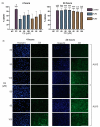De Novo Self-Assembling Peptides Mediate the Conversion of Temozolomide and Delivery of a Model Drug into Glioblastoma Multiforme Cells
- PMID: 36140265
- PMCID: PMC9495814
- DOI: 10.3390/biomedicines10092164
De Novo Self-Assembling Peptides Mediate the Conversion of Temozolomide and Delivery of a Model Drug into Glioblastoma Multiforme Cells
Abstract
Glioblastoma multiforme (GBM) is the most aggressive central nervous system tumor, and standard treatment, including surgical resection, radiation, and chemotherapy, has not significantly improved patient outcomes over the last 20 years. Temozolomide (TMZ), the prodrug most commonly used to treat GBM, must pass the blood-brain barrier and requires a basic pH to convert to its active form. Due to these barriers, less than 30% of orally delivered TMZ reaches the central nervous system and becomes bioactive. In this work, we have developed a novel biomaterial delivery system to convert TMZ to its active form and that shows promise for intracellular TMZ delivery. Self-assembling peptides were characterized under several different assembly conditions and evaluated for TMZ loading and conversion. Both solvent and method of assembly were found to affect the supramolecular and secondary structure of peptide assemblies. Additionally, as peptides degraded in phosphate-buffered saline, TMZ was rapidly converted to its active form. This work demonstrates that peptide-based drug delivery systems can effectively create a local stimulus during drug delivery while remaining biocompatible. This principle could be used in many future biomedical applications in addition to cancer treatment, such as wound healing and regenerative medicine.
Keywords: glioblastoma multiforme; self-assembling peptides; temozolomide.
Conflict of interest statement
The authors declare no conflict of interest. The funders had no role in the design of the study; in the collection, analyses, or interpretation of data; in the writing of the manuscript, or in the decision to publish the results.
Figures










Similar articles
-
Combination therapy in a xenograft model of glioblastoma: enhancement of the antitumor activity of temozolomide by an MDM2 antagonist.J Neurosurg. 2017 Feb;126(2):446-459. doi: 10.3171/2016.1.JNS152513. Epub 2016 May 13. J Neurosurg. 2017. PMID: 27177180 Free PMC article.
-
A tumor-targeting p53 nanodelivery system limits chemoresistance to temozolomide prolonging survival in a mouse model of glioblastoma multiforme.Nanomedicine. 2015 Feb;11(2):301-11. doi: 10.1016/j.nano.2014.09.005. Epub 2014 Sep 18. Nanomedicine. 2015. PMID: 25240597 Free PMC article.
-
Intranasal Delivery of Temozolomide-Conjugated Gold Nanoparticles Functionalized with Anti-EphA3 for Glioblastoma Targeting.Mol Pharm. 2021 Mar 1;18(3):915-927. doi: 10.1021/acs.molpharmaceut.0c00911. Epub 2021 Jan 8. Mol Pharm. 2021. PMID: 33417456
-
Improving temozolomide biopharmaceutical properties in glioblastoma multiforme (GBM) treatment using GBM-targeting nanocarriers.Eur J Pharm Biopharm. 2021 Nov;168:76-89. doi: 10.1016/j.ejpb.2021.08.011. Epub 2021 Aug 28. Eur J Pharm Biopharm. 2021. PMID: 34461214 Review.
-
Temozolomide resistance in glioblastoma multiforme.Genes Dis. 2016 May 11;3(3):198-210. doi: 10.1016/j.gendis.2016.04.007. eCollection 2016 Sep. Genes Dis. 2016. PMID: 30258889 Free PMC article. Review.
Cited by
-
Electrospun Drug-Loaded and Gene-Loaded Nanofibres: The Holy Grail of Glioblastoma Therapy?Pharmaceutics. 2023 Jun 3;15(6):1649. doi: 10.3390/pharmaceutics15061649. Pharmaceutics. 2023. PMID: 37376095 Free PMC article. Review.
References
-
- Bikhezar F., de Kruijff R.M., van der Meer A.J.G.M., Villa G.T., van der Pol S.M.A., Aragon G.B., Garcia A.G., Narayan R.S., de Vries H.E., Slotman B.J., et al. Preclinical evaluation of binimetinib (MEK162) delivered via polymeric nanocarriers in combination with radiation and temozolomide in glioma. J. Neurooncol. 2019;146:239–246. doi: 10.1007/s11060-019-03365-y. - DOI - PMC - PubMed
Grants and funding
LinkOut - more resources
Full Text Sources

